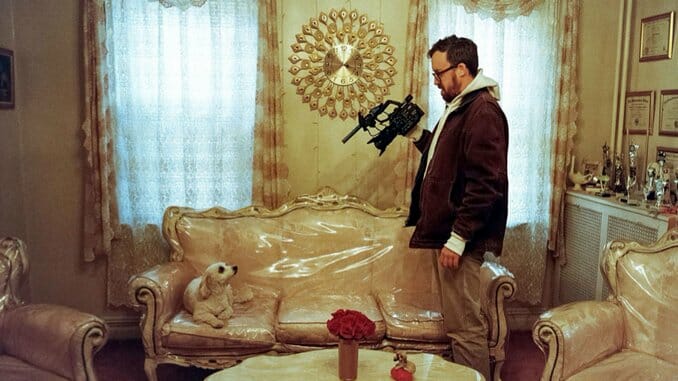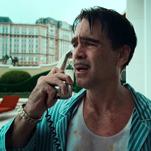How To with John Wilson Is 2020’s Most Essential Comedy Series
Photos courtesy of HBO
At this point, in the waning hours of a year to forget, our endless collective bemoaning of 2020 has just become another one of its many torments. These 365 days have found us sapped of caring and empathy, with the election throwing an ever-widening societal divide into sharp relief. We’re cooped up and afraid of everyone around us—and those of us who already felt that way aren’t exactly thrilled that society at large has joined in. The pandemic has poisoned the well of public life, training us to view every interaction as, first and foremost, a potential vector for the spread of a deadly disease. We’ve lost loved ones, whether to COVID-19 or to varying degrees of estrangement, straining under the weight of a crisis unprecedented in our lifetimes. All this overwhelmingly bleak and upsetting context is exactly what makes HBO’s How To with John Wilson so special: The half-hour comedy docuseries is the antidote to all 2020’s existential despair, a singular story of togetherness and understanding that overflows with the exact qualities this year has so sorely lacked.
How To was first announced last August, a mere footnote in a report about executive producer Nathan Fielder’s (Nathan for You) overall deal with HBO. The show’s first season seemed to sneak onto the network in October, airing through November and building word-of-mouth adulation week after week, and it’s since been widely hailed as one of 2020’s best comedy series. The premise is simple: Filmmaker and self-described “anxious New Yorker” John Wilson, who co-writes and directs each of Season 1’s six episodes, trains his trusty camera on the streets and people of New York City, delivering a different how-to lesson each week. Most of the show consists of footage of various strangers, animals, objects or settings around the city, with Wilson’s quirky, dryly comic narration tying each subject’s threads (and dense web of sight gags) together. The episodes are titled for their focus, but what sound like straightforward, practical tutorials—”How to Put Up Scaffolding,” for instance, or “How to Split the Check”—invariably twist and turn in unexpected ways as Wilson, who is learning along with us as much is he is teaching, finds the profound and the emotional in the everyday.
In episode four, determining how best to go about covering one’s furniture in plastic becomes a contemplation of the lengths to which we’ll go to assert control over our environment, and the imagined value we derive from keeping our ultimately meaningless possessions immaculate. When Wilson attempts to improve his memory in the third episode, he begins to wonder whether subjective truth is even worth preserving before falling in with a group of Mandela effect obsessives who point to faulty memories as evidence of parallel timelines and the multiverse. And in educating his viewers on “How to Make Small Talk” in the premiere episode, Wilson moves from basic etiquette suggestions to studying the idiosyncrasies of human connection in minute detail, making good on the pitch he and Fielder reportedly sold the show on: It’s “Planet Earth, but for New York.” These contemplations unspool organically (or at least feel as if they do) from the empathy Wilson not only offers to his subjects, but also requires in turn from the viewer. Sometimes—most strikingly in the powerful finale—he narrates in the second person, describing his experiences as if they belong to you; other times, he sets his voiceover to candid footage of strangers emoting, intuiting what they are experiencing and fitting that perception into the narrative of his observations.
The nature of Wilson’s observation is what sets the show apart. He and his camera are a character, but they rarely appear on screen—rather, Wilson keeps our eyes on humanity in general, establishing an ethos of curiosity, open-mindedness and community. We learn a bit about Wilson, meeting his ex, his friends and his cat, Baby, and seeing where he used to work shooting infomercials, but everything points to his quiet, yet powerful desire for companionship, underscoring his approach to the show. Oftentimes, he’ll encounter a stranger and follow them down a rabbit hole, shaping his how-tos around their world views. “Mr. 17540,” with whom Wilson makes small talk outside of Wrestlemania in episode one, is an amateur child predator catcher; a soccer ref Wilson meets in a referee store tips him off about a dinner for referees, which he attends in hopes of studying “a masterclass in considerate dining” for “How to Split the Check”; and no random encounter is as memorable as Wilson’s chance meeting with an anti-circumcision advocate who not only demonstrates his patented foreskin restoration device while fully hanging dong, but also performs a song from his anti-circumcision album, which later plays over the credits of “How to Cover Your Furniture.” Contrary to so many other comedy shows of this stripe, How To never mocks or belittles these people, instead presenting their perspectives, however unusual, as valuable insights that help to shape Wilson’s—and our—understanding of how the world works.
Quite a bit of this good-faith depiction stems from Wilson himself, who gives the distinct impression that he cares about every rando he rubs elbows with. It doesn’t feel right to term his participation as a “performance,” even though it is—his nasal, lisping narration is unerringly endearing, and never feels stilted or affected. He trips over words while narrating and corrects himself mid-sentence, leaving such little mistakes in the finished voiceover rather than re-recording them. These touches of unvarnished authenticity accumulate, humanizing Wilson and giving him the air of a truly objective observer behind the camera, rather than any kind of authority. This shows in how Wilson’s subjects deal with him: People just open up like waiting room magazines, as if he possesses some strange magic. A travel agent recounts her romantic history; a solo spring breaker discusses his social anxiety and a friend who died by suicide; a random pedestrian describes in detail a kinky sexual encounter he had that involved a scaffold. And Wilson takes it all in stride (“The world is full of people that need to get something off their chest,” he observes in “How to Make Small Talk”), giving these deeply human stories space to bloom. The show derives much of its power from these spontaneous interactions that lead to unexpected intimacy, a testament to the prismatic power of living in a society.
Wilson’s generosity of spirit is everything 2020 has been missing, and the result is a series littered with grace notes, like little snacks for the soul. Kyle MacLachlan endlessly swiping his Metro card; a montage of strange chairs, abandoned around the city, “seducing” would-be owners; a construction worker dancing while demolishing a favorite old movie theater of Wilson’s (“At least they were having a good time,” he good-naturedly narrates); a hotdog cart rolling, unattended, down the street; the singularly wholesome, yet graphic scene in which Wilson and the anti-circumcision entrepreneur bond over their love of Parasite while the latter lies pants-less on his bed, his penis attached to a pulley system of his own design; inflatable couch cushions blowing in the breeze across a resort courtyard. A significant chunk of How To consists of this “American Beauty dancing bag” sort of serendipity, capturing the poetry of civilization’s imperfection. Wilson studies not only his NYC homebase, but also travels to Mexico, Louisiana, Idaho and elsewhere, casting a wide net in which to all the more effectively snare the minute details of a day on Earth. And he takes us along for the ride, in more ways than one: How To almost has the feel of a video diary, with Wilson often narrating his travels in detail, from what he eats to when he goes to bed. It’s all the more like you’re seeing life through his eyes, experiencing a world we currently keep at arm’s length.
So long, 2020. #HowTowithJohnWilsonpic.twitter.com/t9IXUDyG0J
— How To with John Wilson (@howtojohnwilson) December 31, 2020
That’s the tragic beauty of all this: The elephant in the room of 2020, the COVID-19 pandemic, makes its presence felt in How To, as well, with the very contrast we’re discussing lending a particular poignance to the season finale. The almost unbearably sweet episode finds Wilson attempting to make “the perfect risotto” for his landlord, a lovely old woman who exemplifies why Wilson is so enamored with his fellow human beings. They regularly watch Jeopardy! together in her apartment, and she gives him slippers to make sure his feet aren’t cold. She insists he call her “Mama,” picks the trash out of his can so he can save money on bags, shows her the art she makes, brings him little gifts of cactus and cucumbers, does his laundry, and cooks for him often. “She’s the only person in my life that I never vape around,” says Wilson, who confronts his nicotine addiction in the episode to better clear his head and focus on perfecting her favorite dish so he can reciprocate her kindness. And it’s quietly heart-wrenching to see their relationship affected by the onset of the pandemic, a thief in the night that, by the time Wilson fully takes notice of it, has disrupted all he held dear. “When your world gets turned upside down, it can be hard to figure out the new rules and how to follow them,” he laments, looking back on six episodes of lessons now upended by the pandemic.
How To with John Wilson is wonderful in every way that 2020 hasn’t been, the actual balm for chapped psyches in a year in which every remotely good thing has been called a “balm.” It’s a testament to the power of pointing a camera at life and finding the meaning in what we see—the emotional catharsis and understanding to be had from stories. The “every person for themselves” mindset has defined this year, punching a gaping hole in our hope for the collective pursuit of a greater good, but Wilson’s show is a resonant example of all the beauty to be found via the opposite avenue—a vision of what our society can be. And though it’s hard to say what this show will become—it was recently renewed for a second season—it’s already given us just what we needed: a bright light in a dark time, not only a document of the impossible alchemy that makes life worth living, but also a reminder of all we have to look forward to once we finally reach the other side.
Season 1 of How To with John Wilson is currently streaming on HBO Max.
Scott Russell is an associate music editor at Paste and he’ll come up with something clever later. He’s on Twitter, if you’re into tweets: @pscottrussell.







































